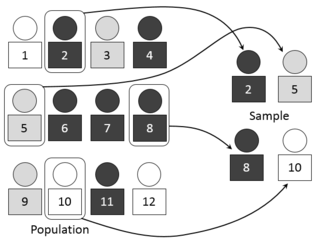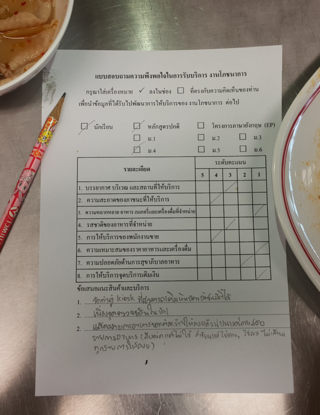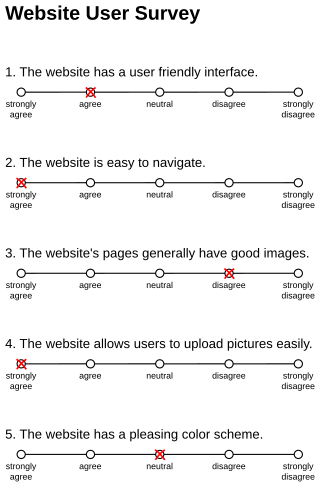In statistics, survey sampling describes the process of selecting a sample of elements from a target population to conduct a survey. The term "survey" may refer to many different types or techniques of observation. In survey sampling it most often involves a questionnaire used to measure the characteristics and/or attitudes of people. Different ways of contacting members of a sample once they have been selected is the subject of survey data collection. The purpose of sampling is to reduce the cost and/or the amount of work that it would take to survey the entire target population. A survey that measures the entire target population is called a census. A sample refers to a group or section of a population from which information is to be obtained.
The theory of statistics provides a basis for the whole range of techniques, in both study design and data analysis, that are used within applications of statistics. The theory covers approaches to statistical-decision problems and to statistical inference, and the actions and deductions that satisfy the basic principles stated for these different approaches. Within a given approach, statistical theory gives ways of comparing statistical procedures; it can find a best possible procedure within a given context for given statistical problems, or can provide guidance on the choice between alternative procedures.
Randomization is a statistical process in which a random mechanism is employed to select a sample from a population or assign subjects to different groups. The process is crucial in ensuring the random allocation of experimental units or treatment protocols, thereby minimizing selection bias and enhancing the statistical validity. It facilitates the objective comparison of treatment effects in experimental design, as it equates groups statistically by balancing both known and unknown factors at the outset of the study. In statistical terms, it underpins the principle of probabilistic equivalence among groups, allowing for the unbiased estimation of treatment effects and the generalizability of conclusions drawn from sample data to the broader population.

In statistics, quality assurance, and survey methodology, sampling is the selection of a subset or a statistical sample of individuals from within a statistical population to estimate characteristics of the whole population. The subset is meant to reflect the whole population and statisticians attempt to collect samples that are representative of the population. Sampling has lower costs and faster data collection compared to recording data from the entire population, and thus, it can provide insights in cases where it is infeasible to measure an entire population.

Rensis Likert was an American organizational and social psychologist known for developing the Likert scale, a psychometrically sound scale based on responses to multiple questions. The scale has become a method to measure people's thoughts and feelings from opinion surveys to personality tests. Likert also founded the theory of participative management, which is used to engage employees in the workplace. Likert's contributions in psychometrics, research samples, and open-ended interviewing have helped form and shape social and organizational psychology.
Questionnaire construction refers to the design of a questionnaire to gather statistically useful information about a given topic. When properly constructed and responsibly administered, questionnaires can provide valuable data about any given subject.
Survey methodology is "the study of survey methods". As a field of applied statistics concentrating on human-research surveys, survey methodology studies the sampling of individual units from a population and associated techniques of survey data collection, such as questionnaire construction and methods for improving the number and accuracy of responses to surveys. Survey methodology targets instruments or procedures that ask one or more questions that may or may not be answered.

The American Community Survey (ACS) is an annual demographics survey program conducted by the U.S. Census Bureau. It regularly gathers information previously contained only in the long form of the decennial census, including ancestry, US citizenship status, educational attainment, income, language proficiency, migration, disability, employment, and housing characteristics. These data are used by many public-sector, private-sector, and not-for-profit stakeholders to allocate funding, track shifting demographics, plan for emergencies, and learn about local communities.

A questionnaire is a research instrument that consists of a set of questions for the purpose of gathering information from respondents through survey or statistical study. A research questionnaire is typically a mix of close-ended questions and open-ended questions. Open-ended, long-term questions offer the respondent the ability to elaborate on their thoughts. The Research questionnaire was developed by the Statistical Society of London in 1838.

Response bias is a general term for a wide range of tendencies for participants to respond inaccurately or falsely to questions. These biases are prevalent in research involving participant self-report, such as structured interviews or surveys. Response biases can have a large impact on the validity of questionnaires or surveys.
In sociology and statistics research, snowball sampling is a nonprobability sampling technique where existing study subjects recruit future subjects from among their acquaintances. Thus the sample group is said to grow like a rolling snowball. As the sample builds up, enough data are gathered to be useful for research. This sampling technique is often used in hidden populations, such as drug users or sex workers, which are difficult for researchers to access. As sample members are not selected from a sampling frame, snowball samples are subject to numerous biases. For example, people who have many friends are more likely to be recruited into the sample. When virtual social networks are used, then this technique is called virtual snowball sampling.
In social science research, social-desirability bias is a type of response bias that is the tendency of survey respondents to answer questions in a manner that will be viewed favorably by others. It can take the form of over-reporting "good behavior" or under-reporting "bad", or undesirable behavior. The tendency poses a serious problem with conducting research with self-reports. This bias interferes with the interpretation of average tendencies as well as individual differences.

In survey research, response rate, also known as completion rate or return rate, is the number of people who answered the survey divided by the number of people in the sample. It is usually expressed in the form of a percentage. The term is also used in direct marketing to refer to the number of people who responded to an offer.

Leslie Kish was a Hungarian-American statistician and survey methodologist.
Cognitive pretesting, or cognitive interviewing, is a field research method where data is collected on how the subject answers interview questions. It is the evaluation of a test or questionnaire before it's administered. It allows survey researchers to collect feedback regarding survey responses and is used in evaluating whether the question is measuring the construct the researcher intends. The data collected is then used to adjust problematic questions in the questionnaire before fielding the survey to the full sample of people.
The Metallic Metals Act was a fictional piece of legislation included in a 1947 American opinion survey conducted by Sam Gill and published in the March 14, 1947, issue of Tide magazine. When given four possible replies, 70% of respondents claimed to have an opinion on the act. It has become a classic example of the risks of meaningless responses to closed-ended questions and prompted the study of the pseudo-opinion phenomenon.

In research of human subjects, a survey is a list of questions aimed for extracting specific data from a particular group of people. Surveys may be conducted by phone, mail, via the internet, and also in person in public spaces. Surveys are used to gather or gain knowledge in fields such as social research and demography.
Participation bias or non-response bias is a phenomenon in which the results of elections, studies, polls, etc. become non-representative because the participants disproportionately possess certain traits which affect the outcome. These traits mean the sample is systematically different from the target population, potentially resulting in biased estimates.
With the application of probability sampling in the 1930s, surveys became a standard tool for empirical research in social sciences, marketing, and official statistics. The methods involved in survey data collection are any of a number of ways in which data can be collected for a statistical survey. These are methods that are used to collect information from a sample of individuals in a systematic way. First there was the change from traditional paper-and-pencil interviewing (PAPI) to computer-assisted interviewing (CAI). Now, face-to-face surveys (CAPI), telephone surveys (CATI), and mail surveys are increasingly replaced by web surveys. In addition, remote interviewers could possibly keep the respondent engaged while reducing cost as compared to in-person interviewers.
The interviewer effect is the distortion of response to an interviewer-administered data collection effort which results from differential reactions to the social style and personality of interviewers or to their presentation of particular questions. The use of fixed-wording questions is one method of reducing interviewer bias. Anthropological research and case-studies are also affected by the problem, which is exacerbated by the self-fulfilling prophecy, when the researcher is also the interviewer it is also any effect on data gathered from interviewing people that is caused by the behavior or characteristics of the interviewer.







